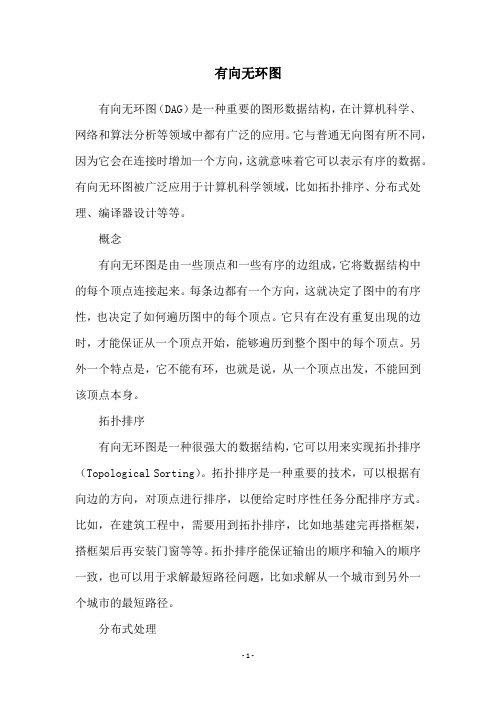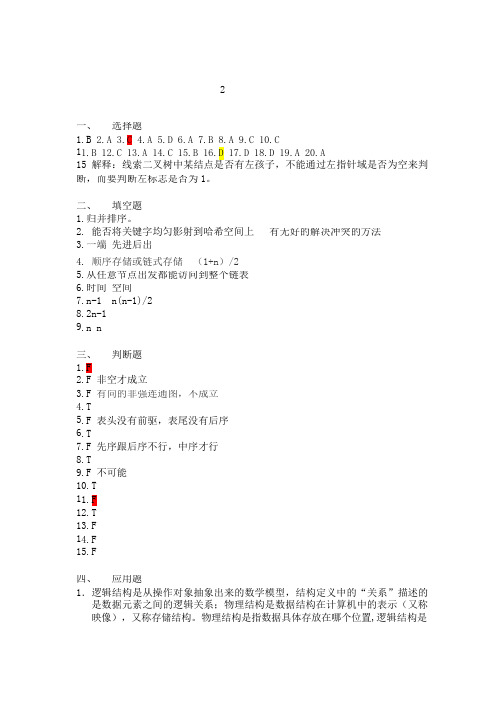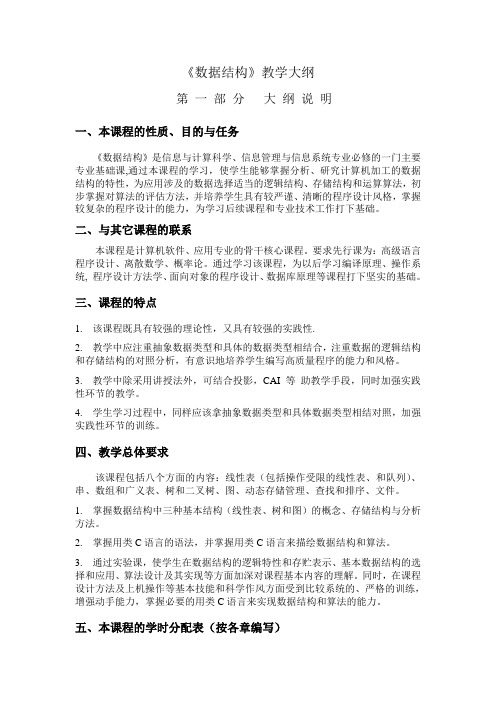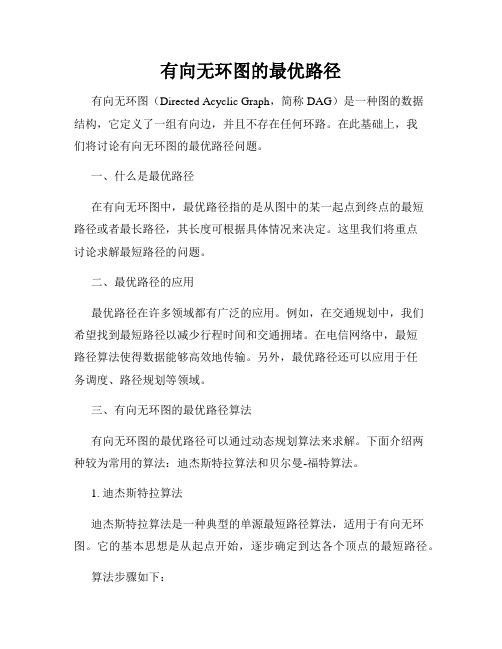数据结构有向无环图及其应用
7.5有向无环图及其应用(精)

2018/9/21
数据结构
关键活动:关键路径上的活动都是关键 活动。
(1)关键路径上的各项活动能按期或
提前完成,则整个工程则能按期或提前
完成。 (2)如果关键活动拖延了时间,整个 工程的工期必定拖延。
14
2018/9/21
数据结构
1)事件vj的最早发生时间Ve(j)
是从源点到顶点vj的最长路径长度,这个时
6 2018/9/21
数据结构
逆拓扑排序,其方法和步骤与拓扑排序 正好形成对偶关系: (1)在AOV网中选取一个没有后继 (即出度为0)的顶点并输出之。 (2)从AOV网中删除该顶点以及射向 该顶点的所有有向边(可以用有向边发出 的顶点的出度减1实现)。 (3)重复(1)、(2),直至全部顶 点输出完毕(逆拓扑排序成功),或者再 也找不到没有后继的顶点(逆拓扑排序失 败)为止。
10 2018/9/21
7.5.2 关键路径
数据结构
1. AOE网 如果在带权的有向图中,用顶点 表示事件,用有向边表示活动,边上 的权表示活动持续的时间,这种带权 的有向图称为AOE网(Activity On Edge Network)。
11
2018/9/21
数据结构
12
2018/9/21
2. 关键路径
7 2018/9/21
数据结构
#define MAXVER 21 typedef struct listnode { int adjvex; struct listnode *next; }listnode; typedef struct { int indegree; listnode *first; }headnode; typedef struct
第7章 图-有向无环图

算法的执行步骤: 算法的执行步骤: 1、用一个数组记录每个结点的入度。将入度为零的 、用一个数组记录每个结点的入度。 结点进栈。 结点进栈。 2、将栈中入度为零的结点V输出。 、将栈中入度为零的结点 输出 输出。 3、根据邻接表找到结点 的所有的邻接结点, 并将 、根据邻接表找到结点V的所有的邻接结点 的所有的邻接结点, 这些邻接结点的入度减一。 这些邻接结点的入度减一 。 如果某一结点的入度变 为零,则进栈。 为零,则进栈。
3
2
3、找到全为零的第 k 列,输出 k 、 4、将第 k 行的全部元素置为零 、 行的全部元素置为零
…………………
7
53、4;直至所有元素输出完毕。 、 ;直至所有元素输出完毕。
1 2 3 4 5 6 7
0 1 1 0 0 0 0 0 0 0 0 1 1 1 0 0 0 0 1 0 1 0 0 0 0 0 0 0 0 0 0 0 0 0 1 0 0 0 0 0 0 1 0 0 0 0 0 0 0
template<class T> int BinaryTree <T>:: NumOfOne ( node <T> *t )
{ int k=0; if (t==NULL ) //空二叉树 //空二叉树 return 0; if (t所指结点 的度为 k=1 所指结点 的度为1) k=1; d1= NumOfOne ( t->lchild); //递归求左子树叶结点数 //递归求左子树叶结点数 d2= NumOfOne ( t->rchild); } //递归求右子树叶结点数 //递归求右子树叶结点数 return (d1+d2+k);
A B
AOE网络:结点为事件,有向边指向表示事件的执行次序。 网络:结点为事件,有向边指向表示事件的执行次序。 网络 有向边定义为活动,边的权值为活动进行所需要的时间。 有向边定义为活动,边的权值为活动进行所需要的时间。
数据结构-有向无环图及其应用

WENKU DESIGN
2023-2026
ONE
KEEP VIEW
数据结构-有向无环图 及其应用
WENKU DESIGN
WENKU DESIGN
WENKU
REPORTING
https://
CATALOGUE
目 录
• 引言 • 有向无环图的基本概念 • 有向无环图的构建 • 有向无环图的应用场景 • 有向无环图的实际应用案例 • 有向无环图的未来研究方向和挑战
详细描述
目前有向无环图已经在许多领域得到应用,如社交网络分析、生物信息学和推荐系统等。未来可以进 一步探索有向无环图在金融、交通和能源等领域的应用,挖掘其更大的潜力。
提高有向无环图的表示能力和分析精度
总结词
提高有向无环图的表示能力和分析精度 是另一个重要的研究方向,旨在更好地 表示复杂数据关系和提高分析结果的准 确性。
拓扑排序
有向无环图可以用于进行拓扑排 序,即将图中所有节点按照依赖 关系进行排序,使得对于任何一 条从节点i到节点j的有向边,i都
在j之前出现。
关键路径
在项目管理中有向无环图可以用 于确定项目的关键路ห้องสมุดไป่ตู้,即确定
项目的最短完成时间路径。
PART 03
有向无环图的构建
构建有向无环图的算法
基于邻接矩阵的算法
通过构建一个二维矩阵来表示图的节点之间的关系,如果存在一条从节点i到节点j的 边,则矩阵中第i行第j列的值为1,否则为0。
基于邻接表的算法
使用一个列表来存储每个节点所连接的节点,如果存在一条从节点i到节点j的边 ,则在节点i的列表中添加节点j。
构建有向无环图的步骤
01
有向无环图

有向无环图有向无环图(DAG)是一种重要的图形数据结构,在计算机科学、网络和算法分析等领域中都有广泛的应用。
它与普通无向图有所不同,因为它会在连接时增加一个方向,这就意味着它可以表示有序的数据。
有向无环图被广泛应用于计算机科学领域,比如拓扑排序、分布式处理、编译器设计等等。
概念有向无环图是由一些顶点和一些有序的边组成,它将数据结构中的每个顶点连接起来。
每条边都有一个方向,这就决定了图中的有序性,也决定了如何遍历图中的每个顶点。
它只有在没有重复出现的边时,才能保证从一个顶点开始,能够遍历到整个图中的每个顶点。
另外一个特点是,它不能有环,也就是说,从一个顶点出发,不能回到该顶点本身。
拓扑排序有向无环图是一种很强大的数据结构,它可以用来实现拓扑排序(Topological Sorting)。
拓扑排序是一种重要的技术,可以根据有向边的方向,对顶点进行排序,以便给定时序性任务分配排序方式。
比如,在建筑工程中,需要用到拓扑排序,比如地基建完再搭框架,搭框架后再安装门窗等等。
拓扑排序能保证输出的顺序和输入的顺序一致,也可以用于求解最短路径问题,比如求解从一个城市到另外一个城市的最短路径。
分布式处理有向无环图也可以用来实现分布式处理(Distributed Processing),它可以把任务分解成一些独立的子任务,然后把它们连接起来,形成有向无环图,这样每一个子任务可以在不同的处理器上完成。
分布式处理可以使用有向无环图的拓扑排序算法,实现对任务的排序,从而保证任务的正确执行。
同时,由于它不存在环路,因此也可以保证它是安全的,不会出现死锁的情况,这样也就可以保证流程的有序性。
编译器设计有向无环图也可以用于编译器设计(Compiler Design)。
编译器是计算机科学中一种重要的应用,它可以把高级语言翻译成机器语言,从而可以让计算机处理高级语言编写的程序。
有向无环图可以用来构建编译器,因为它可以实现对语句的排序,这样可以保证编译器在编译过程中符合语法规则,并且能够正确翻译,从而使程序能够正确执行。
有向无环图(DAG)技术:超越区块链的分布式账本

区块链 交易量与效率成正比,超越区块链的分布式账本:有向无环图(DAG)技术一、起源DAG(Directed Acyclic Graph,有向无环图)是一种数据结构,最早提出在区块链中加入DAG 概念作为算法,是在2013年的bitcointalk论坛,被称作为“Ghost协议”,这一提议也是为了解决当时比特币的扩容问题。
后来,在NXT社区,又有人提出了DAG of block,将DAG的拓扑结构用来存储区块,解决效率问题。
那时对于DAG的应用,还停留在类似于侧链的一个认识。
众所周知,扩展性是当前区块链技术急需解决的难点之一。
谈到扩展性,首当其冲的便是区块链的扩容问题,当区块链上的交易频繁时,区块链的性能也呈会线性下滑。
参考以太坊的容量,仅仅一个加密猫游戏就让区块链不堪重负,造成了巨大拥堵。
所以,如何有效地扩容,成为了当下区块链技术的一大重点。
在PoW算法的区块链中尤其如此,由于PoW机制是将交易数据打包成区块,在由算力高的节点进行记账,这种算法相对于PoS速度较慢,交易量上升更加会影响到整体的确认速度,以比特币为例,一开始比特币区块链大小为1M,后来交易量的上升使得社区不得不考虑扩容方案,还因此引发了扩容之争与分叉事件。
PoS在确认速度上大为改善,但仍然难以跟上需求。
同时,PoW和PoS算法都有趋向于中心化的理论风险,当拥有的算力或者代币达到了一定数量时,区块链就会变得中心化。
DAG也是一种分布式账本技术,与区块链不同。
因为区块链是由区块组成的一条单链,而DAG则是由交易组成的网络。
但本质上,两者却有着很大的相似之处。
DAG中的交易,就可以看做是一个个“区块”,只不过这些区块也可以作为节点,形成一个复杂交织的网络拓扑结构。
DAG与PoW、PoS相比,DAG有着更加高的性能,甚至可以说交易越多、节点越多,处理速度越快。
二、工作原理DAG技术如何在作为一个分布式账本进行应用呢?IOTA是应用DAG技术较为知名的一个项区块链 目,它将DAG进行了改进,并提出Tangle(缠结)方案。
数据结构-第7章图答案

7.3 图的遍历 从图中某个顶点出发游历图,访遍图中其余顶点, 并且使图中的每个顶点仅被访问一次的过程。 一、深度优先搜索 从图中某个顶点V0 出发,访问此顶点,然后依次 从V0的各个未被访问的邻接点出发深度优先搜索遍 历图,直至图中所有和V0有路径相通的顶点都被访 问到,若此时图中尚有顶点未被访问,则另选图中 一个未曾被访问的顶点作起始点,重复上述过程, 直至图中所有顶点都被访问到为止。
void BFSTraverse(Graph G, Status (*Visit)(int v)) { // 按广度优先非递归遍历图G。使用辅助队列Q和访问标志数组 visited。 for (v=0; v<G.vexnum; ++v) visited[v] = FALSE; InitQueue(Q); // 置空的辅助队列Q for ( v=0; v<G.vexnum; ++v ) if ( !visited[v]) { // v尚未访问 EnQueue(Q, v); // v入队列 while (!QueueEmpty(Q)) { DeQueue(Q, u); // 队头元素出队并置为u visited[u] = TRUE; Visit(u); // 访问u for ( w=FirstAdjVex(G, u); w!=0; w=NextAdjVex(G, u, w) ) if ( ! visited[w]) EnQueue(Q, w); // u的尚未访问的邻接顶点w入队列Q
4。邻接多重表
边结点
mark ivex
顶点结点
ilink
jvex
jlink
info
data
firstedge
#define MAX_VERTEX_NUM 20 typedef emnu {unvisited, visited} VisitIf; typedef struct Ebox { VisitIf mark; // 访问标记 int ivex, jvex; // 该边依附的两个顶点的位置 struct EBox *ilink, *jlink; // 分别指向依附这两个顶点的下一条 边 InfoType *info; // 该边信息指针 } EBox; typedef struct VexBox { VertexType data; EBox *firstedge; // 指向第一条依附该顶点的边 } VexBox; typedef struct { VexBox adjmulist[MAX_VERTEX_NUM]; int vexnum, edgenum; // 无向图的当前顶点数和边数 } AMLGraph;
数据结构(C语言版CHAP7(2)

V1
AOE网
a0
a7
V2 V6
a2 a3
V3
a5
a8
V4
V5
a1
V7 a 6 V 8 a4
结束
第 15 页
7.4
有向无环图的应用
为计算完成整个工程至少需要多少时间,需将每一子工程所需的时 间作为权值赋给AOE网的各边(就象哈夫曼树给结点赋权值一样)。 AOE网与关键路径部分,不作为课程要求。
V1
a0
V0
V1
V3
V4
V5
V6
结束
第 3 页
7.4
有向无环图的应用
2 AOE网( activity on edge net ) 用边表示活动,顶点表示事件的有向图称为AOE网。 事件发生表示以 该事件为起点的活动可以开始,以该事件为终点的活动已经结束。
a1 a2 a3 a4 a5 a6 分别表示例1中的7个子工程V0、V1、V2、V3、V4、V5、V6。a7 a8
结束
第 14 页
7.4
三 AOE网与关键路径
对工程人们关心两类问题:
有向无环图的应用
1)工程能否顺序进行,即工程流程是否“合理” 2)完成整项工程至少需要多少时间,哪些子工程是影响工程进度的关键 子工程? 为解决第二类问题,通常可用称为AOE网的有向图表示工程流程 用边表示活动,顶点表示事件。 事件发生表示以该事件为起点的活动可 以开始,以该事件为终点的活动已经结束。
结束
第 12 页
7.4
有向无环图的应用
4)拓扑排序算法 Status TopologicalSort(ALGraph G) { //有向图G采用邻接表存储结构。 //若G无回路,则输出G的顶点的一个拓扑序列并返回OK,否则ERROR。 FindInDegree(G, indegree); //求各顶点入度indegree[0..vernum-1] InitStack(S); For(i=0; i<G. vexnum; ++i) //建入度为0的顶点栈S indegree 0 0 if (! Indegree[i]) Push(S, i); //入度为0顶点的编号进栈 1 0 6 2 1 5 V3 3 2 4 4 2 3 V1 V4 V6 5 3 S.top 2 6 2 1 1 V2 V5 V7 S.base 0 0
(16)有向无环图及其应用讲解

1
一、定义
一个无环的有向图称为有向无环图,简写为 DAG(directed acycline graph)。 与有向二叉树相比,有向无环图是更一般的特 殊有向图。 实例:
有向树
有向无环图
有向图
有向无环图的一个简单应用: 用有向无环图描述 2 算术表达式。
二、拓扑排序
1.引例:现有计算机课程12门,如下表所示:
vertex
adjvexnextadj firstedge
0
v1
v2
13v4源自v3254
v5
v6
另外增设一个存放各顶点的入度值的一维数组indegree:
indegree[0..5] 0 0 2 1 1 2 2 3 3 4 0 5
10
二、拓扑排序
indegree一维数组初值的程序: 4.求 算法说明:为了使说明过程简单起见,我们以下 FindInDegree(ALGraph G,indegree[0..G.vexnum-1]){ 图为例:
拓扑序列:C1 C2 C3 C4 C5 C7 C9 C10 C11 C6 C12 C8
8
二、拓扑排序
3.方法: 注意1 :从某种意义下来说,拓扑排序的结果是不 唯一的。 注意2 :这种以顶点表示活动的有向无环图称为活动 在顶点的网,简称AOV(Activity On Vertex Network) 网。 注意3 :当有向图中包含有向环路时,拓扑排序算法 结束时图中还有若干顶点没有被输出(即有向环路 中的所有顶点没有参加排序)。
C6 C11
6
二、拓扑排序
3.方法:
C4 C5 C2 C1 C3 C7
C12 C9 C10 C8
C6 C11
数据结构-图的定义和术语

继续进行 ·3
·4
搜索。
·5
·6
·7
·3 ·1
·2
·4 从结点 5 出发的搜索序列:
5、6、2、3、1、4、7 适用的数据结构:栈
图的遍历
2、广度(宽度)优先搜索:
• 树:
A
B
C
D
EFG H
I JK
树的按层次进行访问的次序: A、B、C、D、E、F、G、H、 I、J、K、L
适用的数据结构:队列
L A
1
·1
2
12
11
·2
·11
·12
3
6
7
10
·3 ·6 ·7
·10
4
5
8
9
·4 ·5 ·8
·9
图的广度优先的访问次序:
1、2、11、12、3、6、7、10、4、5、8、9
适用的数据结构:队列
图的连通性问题
2、有向图的强连通分量的求法:续 •强连通分量的求法:
1、对有向图 G 进行深度为主的搜索,按照退 出该结点的次序给结点进行编号。最先退 出的结点的编号为 1,其它结点的编号按 次序逐次增大 1。
点1
3 已在U中
16 21 35
0 0 0
lowcost 表示最小距离
4∞ 0
adjvex 表示相应结点(在V -U中的)
5∞
0
lowcost adjvex
U1
6
5 1
25 35 4
3
6
4
2
566 图G
数组:closedge[ 6 ]
00 15 2 20 35 0 46 2 54 2
lowcost adjvex
830数据结构2021-2021真题答案(有错)

2一、 选择题1 1 1 .B 2.A 3.C 4.A 5.D 6.A 7.B 8.A 9.C 10.C1.B 12.C 13.A 14.C 15.B 16.D 17.D 18.D 19.A 20.A5 解释:线索二叉树中某结点是否有左孩子,不能通过左指针域是否为空来判 断,而要判断左标志是否为 1。
二、 填空题1 2 3 .归并排序。
. 能否将关键字均匀影射到哈希空间上.一端 先进后出有无好的解决冲突的方法4 5 6 7 8 9 . 顺序存储或链式存储 (1+n )/2.从任意节点出发都能访问到整个链表.时间 空间.n-1 n(n-1)/2.2n-1.n n三、 判断题 1 2 3 4 5 6 7 8 9 1 1 1 1 1 1 .F.F 非空才成立.F 有向的非强连通图,不成立.T.F 表头没有前驱,表尾没有后序.T.F 先序跟后序不行,中序才行.T.F 不可能0.T1.F2.T3.F4.F5.F四、 应用题1 .逻辑结构是从操作对象抽象出来的数学模型,结构定义中的“关系”描述的 是数据元素之间的逻辑关系;物理结构是数据结构在计算机中的表示(又称 映像),又称存储结构。
物理结构是指数据具体存放在哪个位置,逻辑结构是2 3.由 AOV 网构造拓扑序列的拓扑排序算法主要是循环执行以下两步,直到不存 在入度为 0的顶点为止。
(1) 选择一个入度为 0的顶点并输出之;(2) 从网 中删除此顶点及所有出边。
拓扑序列 1:abcdef 拓扑序列 2:adbcef.二叉树图如下:4 5 .略。
已经不纳入考纲.哈夫曼编码问题编码: 3: 000020: 10 10: 0001 22: 11 18: 001 37: 016.二叉排序树问题比根节点小的往左子树插,大的往右子树插。
图如下:删除50有两种做法:《数据结构》中的解析这里我用第二种做法:五.算法设计题1 & .算法填空(L.elem[i-1]) L.length-1 ++p *p L.length-1;2. 设计算法: 输入 n 个元素的值 创建带头结点的单链线性表 L 。
【图论】有向无环图的拓扑排序

【图论】有向⽆环图的拓扑排序1. 引⾔有向⽆环图(Directed Acyclic Graph, DAG)是有向图的⼀种,字⾯意思的理解就是图中没有环。
常常被⽤来表⽰事件之间的驱动依赖关系,管理任务之间的调度。
拓扑排序是对DAG的顶点进⾏排序,使得对每⼀条有向边(u, v),均有u(在排序记录中)⽐v先出现。
亦可理解为对某点v⽽⾔,只有当v的所有源点均出现了,v才能出现。
下图给出有向⽆环图的拓扑排序:下图给出的顶点排序不是拓扑排序,因为顶点D的邻接点E⽐其先出现:2. 算法原理与实现拓扑排序的实现算法有两种:⼊度表、DFS,其时间复杂度均为O(V+E)。
⼊度表对于DAG的拓扑排序,显⽽易见的办法:找出图中0⼊度的顶点;依次在图中删除这些顶点,删除后再找出0⼊度的顶点;然后再删除……再找出……直⾄删除所有顶点,即完成拓扑排序为了保存0⼊度的顶点,我们采⽤数据结构栈(亦可⽤队列);算法的可视化可参看。
图⽤邻接表(adjacency list)表⽰,⽤数组inDegreeArray[]记录结点的⼊度变化情况。
C实现:// get in-degree arrayint *getInDegree(Graph *g) {int *inDegreeArray = (int *) malloc(g->V * sizeof(int));memset(inDegreeArray, 0, g->V * sizeof(int));int i;AdjListNode *pCrawl;for(i = 0; i < g->V; i++) {pCrawl = g->array[i].head;while(pCrawl) {inDegreeArray[pCrawl->dest]++;pCrawl = pCrawl->next;}}return inDegreeArray;}// topological sort functionvoid topologicalSort(Graph *g) {int *inDegreeArray = getInDegree(g);Stack *zeroInDegree = initStack();int i;for(i = 0; i < g->V; i++) {if(inDegreeArray[i] == 0)push(i, zeroInDegree);}printf("topological sorted order\n");AdjListNode *pCrawl;while(!isEmpty(zeroInDegree)) {i = pop(zeroInDegree);printf("vertex %d\n", i);pCrawl = g->array[i].head;while(pCrawl) {inDegreeArray[pCrawl->dest]--;if(inDegreeArray[pCrawl->dest] == 0)push(pCrawl->dest, zeroInDegree);pCrawl = pCrawl->next;}}}时间复杂度:得到inDegreeArray[]数组的复杂度为O(V+E);顶点进栈出栈,其复杂度为O(V);删除顶点后将邻接点的⼊度减1,其复杂度为O(E);整个算法的复杂度为O(V+E)。
数据结构教学大纲

《数据结构》教学大纲第一部分大纲说明一、本课程的性质、目的与任务《数据结构》是信息与计算科学、信息管理与信息系统专业必修的一门主要专业基础课,通过本课程的学习,使学生能够掌握分析、研究计算机加工的数据结构的特性,为应用涉及的数据选择适当的逻辑结构、存储结构和运算算法,初步掌握对算法的评估方法,并培养学生具有较严谨、清晰的程序设计风格,掌握较复杂的程序设计的能力,为学习后续课程和专业技术工作打下基础。
二、与其它课程的联系本课程是计算机软件、应用专业的骨干核心课程。
要求先行课为:高级语言程序设计、离散数学、概率论。
通过学习该课程,为以后学习编译原理、操作系统, 程序设计方法学、面向对象的程序设计、数据库原理等课程打下坚实的基础。
三、课程的特点1.该课程既具有较强的理论性,又具有较强的实践性.2.教学中应注重抽象数据类型和具体的数据类型相结合,注重数据的逻辑结构和存储结构的对照分析,有意识地培养学生编写高质量程序的能力和风格。
3.教学中除采用讲授法外,可结合投影,CAI等助教学手段,同时加强实践性环节的教学。
4.学生学习过程中,同样应该拿抽象数据类型和具体数据类型相结对照,加强实践性环节的训练。
四、教学总体要求该课程包括八个方面的内容:线性表(包括操作受限的线性表、和队列)、串、数组和广义表、树和二叉树、图、动态存储管理、查找和排序、文件。
1.掌握数据结构中三种基本结构(线性表、树和图)的概念、存储结构与分析方法。
2.掌握用类C语言的语法,并掌握用类C语言来描绘数据结构和算法。
3.通过实验课,使学生在数据结构的逻辑特性和存贮表示、基本数据结构的选择和应用、算法设计及其实现等方面加深对课程基本内容的理解。
同时,在课程设计方法及上机操作等基本技能和科学作风方面受到比较系统的、严格的训练,增强动手能力,掌握必要的用类C语言来实现数据结构和算法的能力。
五、本课程的学时分配表(按各章编写)六、教材及教学参考资料《数据结构(C语言版)》,严蔚敏、吴伟民清华大学出版社1997《数据结构实用教程(C/C++描述),徐孝凯清华大学出版社1999《数据结构—用C语言描述》,宁正元中国水利水电出版社2000《实用数据结构》,徐士良清华大学出版社2000《数据结构》,晋良颖人民邮电出版社2002第二部分教学内容和教学要求第一章:概论教学内容:1.什么是数据结构2.基本概念3.抽象数据类型的表示与实现4.算法和算法分析教学要求:使学生了解数据和数据结构等名词和术语的基本概念,理解数据的逻辑结构和存储结构的概念,它们各自对应的性质和两种结构之间的关系;了解算法的五个要素;理解掌握计算语句的频度和时间。
数据结构:第7章 图4-拓扑排序和关键路径

拓扑排序算法
拓扑排序方法: (1)在AOV网中选一个入度为0的顶点(没有前驱) 且输出之; (2)从AOV网中删除此顶点及该顶点发出来的所 有有向边; (3)重复(1)、(2)两步,直到AOV网中所有 顶点都被输出或网中不存在入度为0的顶点。
从拓扑排序步骤可知,若在第3步中,网中所有顶 点都被输出,则表明网中无有向环,拓扑排序成功。 若仅输出部分顶点,网中已不存在入度为0的顶点, 则表明网中有有向环,拓扑排序不成功。
拓扑序列:C1--C2--C3 (3)
C12 C9 C10
C7 C8 C6
C11
拓扑序列:C1--C2--C3--C4 (4)
C7
C12
C12
C8
C8 C9 C10
C6
C9 C10
C6
C11
C11 拓扑序列:C1--C2--C3--C4--C5
(5)
拓扑序列:C1--C2--C3--C4--C5--C7 (6)
在 (b)中,我们用一种有向图来表示课程开设
拓扑排序
1.定义 给出有向图G=(V,E),对于V中的顶点的线性序列 (vi1,vi2,...,vin),如果满足如下条件:若在G中从 顶点 vi 到vj有一条路径,则在序列中顶点vi必在 顶点 vj之前;则称该序列为 G的一个拓扑序列。 构造有向图的一个拓扑序列的过程称为拓扑排序。 2.说明 (1)在AOV网中,若不存在回路,则所有活动可排成 一个线性序列,使得每个活动的所有前驱活动都排 在该活动的前面,那么该序列为拓扑序列. (2)拓扑序列不是唯一的.
2.AOV网实际意义
现代化管理中, 通常我们把计划、施工过程、生产流程、 程序流程等都当成一个工程,一个大的工程常常被划分 成许多较小的子工程,这些子工程称为活动。在整个工 程实施过程中,有些活动开始是以它的所有前序活动的 结束为先决条件的,必须在其它有关活动完成之后才能 开始,有些活动没有先决条件,可以 安排在任意时间开 始。AOV网就是一种可以形象地反映出整个工程中各个 活动之间前后关系的有向图。例如,计算机专业学生的 课程开设可看成是一个工程,每一门课程就是工程中的 活动,下页图给出了若干门所开设的课程,其中有些课 程的开设有先后关系,有些则没有先后关系,有先后关 系的课程必须按先后关系开设,如开设数据结构课程之 前必须先学完程序设计基础及离散数学,而开设离散数 学则必须先并行学完数学、程序设计基础课程。
有向无环图的最优路径

有向无环图的最优路径有向无环图(Directed Acyclic Graph,简称DAG)是一种图的数据结构,它定义了一组有向边,并且不存在任何环路。
在此基础上,我们将讨论有向无环图的最优路径问题。
一、什么是最优路径在有向无环图中,最优路径指的是从图中的某一起点到终点的最短路径或者最长路径,其长度可根据具体情况来决定。
这里我们将重点讨论求解最短路径的问题。
二、最优路径的应用最优路径在许多领域都有广泛的应用。
例如,在交通规划中,我们希望找到最短路径以减少行程时间和交通拥堵。
在电信网络中,最短路径算法使得数据能够高效地传输。
另外,最优路径还可以应用于任务调度、路径规划等领域。
三、有向无环图的最优路径算法有向无环图的最优路径可以通过动态规划算法来求解。
下面介绍两种较为常用的算法:迪杰斯特拉算法和贝尔曼-福特算法。
1. 迪杰斯特拉算法迪杰斯特拉算法是一种典型的单源最短路径算法,适用于有向无环图。
它的基本思想是从起点开始,逐步确定到达各个顶点的最短路径。
算法步骤如下:(1)初始化:将起点的最短路径设置为0,其他顶点的最短路径设置为无穷大。
(2)选择:选择一个未被访问过的顶点,使得当前被访问的顶点到该顶点的路径长度最短。
(3)更新:通过比较当前路径长度和新路径长度的大小,更新到达其他未被访问过的顶点的最短路径。
(4)重复:重复选择和更新步骤,直到所有顶点都被访问过。
2. 贝尔曼-福特算法贝尔曼-福特算法是一种通用的最短路径算法,适用于一般的有向图,包括带有负权边的图。
算法步骤如下:(1)初始化:将起点的距离设置为0,其他顶点的距离设置为无穷大。
(2)迭代:重复对所有边进行松弛操作,即通过比较当前路径和新路径的长度,更新距离数组中的值。
(3)判断负权环:若经过上述迭代,距离数组仍然在更新,则存在负权环,无法求解最短路径。
四、最优路径的应用举例以城市之间的交通规划为例,假设我们已经构建了一个有向无环图,其中城市之间的道路表示为有向边,而道路的长度表示为边的权重。
有向无环图及其应用

有向树, 图7.15 有向树,DAG图和有向图一例 图和有向图一例
(2)表达式子式共享 ) 例如,下述表达式 例如,下述表达式((a +b ) * (b * (c + d)) + (c + d) * e) * ((c + d) * e),用 , 二叉树表示如图7.16所示,用有向无环图表示如图7.17所示. 所示, 所示. 二叉树表示如图 所示 用有向无环图表示如图 所示 * + * + a b b c * + d 图7.16 用二叉树描述表达式 c + d * e c + d * e
count = 0; while (!StackEmpty (S)) { Pop (S, i); printf (i, G.vertices[i].data); //输出 号顶点并计数 输出i号顶点并计数 输出 ++ count; for (p = G.vertices[i].firstarc; p; p = p->nextarc) { - k = p->adjvex; //对i号顶点的每个邻接点的入度减 号顶点的每个邻接点的入度减1 - 对 号顶点的每个邻接点的入度减 if (!(――indegree[k])) Push (S, k); //若入度减为 ,则入栈 若入度减为0, 若入度减为 } // for } // while if (count < G.vexnum) return ERROR; //该有向图有回路 该有向图有回路 } // TopologicalSort
v6 → v1 → v 4 → v3 → v 2 → v5
£7.5.3 关键路径
(1)定义 ) 关键路径( ):在 网中有些活动可以并行的进行, 关键路径(Critical Path):在AOE-网中有些活动可以并行的进行, ): 网中有些活动可以并行的进行 所以完成工程的最短时间是从开始点到完成点的最长路径的长度( 所以完成工程的最短时间是从开始点到完成点的最长路径的长度(路径 长度是指路径上各活动持续时间之和,而不是路径上弧的数目). ).这个 长度是指路径上各活动持续时间之和,而不是路径上弧的数目).这个 路径长度最长的路径叫关键路径. 路径长度最长的路径叫关键路径. 关键活动: 的活动. 关键活动:l(i) = e(i)的活动.即活动的最早开始时间=最迟开始时间. 的活动 即活动的最早开始时间=最迟开始时间. 显然,关键路径上的所有活动都是关键活动. 显然,关键路径上的所有活动都是关键活动. (2)AOE-网 ) 网 AOE-网(Activity On Edge):即边表示活动的网.AOE-网是一个 网 ):即边表示活动的网 ):即边表示活动的网. 网是一个 带权的有向无环图.其中,顶点表示事件(Event),弧表示活动,权 带权的有向无环图.其中,顶点表示事件( ),弧表示活动, ),弧表示活动 表示活动持续的时间. 表示活动持续的时间.
数据结构第7章图3有向无环图及其应用ppt课件

for(p=G.vertices[i].firstarc; p; p=p->nextarc){ k=p—>adivex;//对i号顶点的每个邻接点入度减1 if(!(--indegree[k])) Push(S,k); //若入度减为0,则入栈
§7.5 有向无环图及其应用
❖有向无环图
在工程实践中,一个工程项目往往由若干个子项 目组成,这些子项目间往往有多种关系:
①先后关系,即必须在一子项目完成后,才能开 始实施另一个子项目;
②子项目之间无次序要求,即两个子项目可以同 时进行,互不影响。
§7.5 有向无环图及其应用
❖两种常用的活动网络(Activity Network)
3
4 4^
4
2 1^ 3^
1^
s
0 V1 3 V4
5 V6
4
V2 1 V3 2 V5 4
indegree[0..5] 0 0 0 0 0 0 012345
最后输出的拓扑序列为:v6v1v3v2v4v5
§7.5 有向无环图及其应用
G.vertices[0] v1
3
2
G.vertices[1] v打2 印^G.vertices[4].data
1. 输入AOV网络。令 n 为顶点个数。 2. 在AOV网络中选一个没有直接前驱的顶点, 并输出之; 3. 从图中删去该顶点, 同时删去所有它发出的有向边; 4. 重复以上 2、3 步, 直到:
全部顶点均已输出,拓扑有序序列形成,拓扑排序完成 或者,图中还有未输出的顶点,但已跳出处理循环。这说 明图中还剩下一些顶点,它们都有直接前驱,再也找不到 没有前驱的顶点了。这时AOV网络中必定存在有向环。
7.5 有向无环图及应用

四、存储结构(邻接表 2 1 2 3 0
id
v1 v2 v3 v4 v5 v6
vex data first arc
4 Χ 5 5 Χ
3
2
Χ
2 0
v1 v2
Χ
5
adjvex next arc
4
Χ
v4
v3
v6
v5
typedef struct arcnode{ int adjvex; arcnode* nextarc; } * pointer; // 表结点 struct node{ char vexdata; int id ; //顶点的入度 顶点的入度 pointer firstarc; } dig[100]; // 一组头结点
有向无环图
三、拓扑排序的过程
v1 v2 v1 v2 (1) 输出顶点 输出顶点v6 (2) 输出顶点 输出顶点v1 v4 v3 (3) 输出顶点 输出顶点v3 v4 v3 (4) 输出顶点 输出顶点v4 (5) 输出顶点 输出顶点v2 v6 v5 v6 v5 (6) 输出顶点 输出顶点v5
有向无环图
if (count<n) error(“该图中存在回路”) 该图中存在回路” 该图中存在回路
} 分析此拓扑排序算法可知,如果AOV网络有 分析此拓扑排序算法可知,如果AOV网络有n 个顶 网络有n 条边, 在拓扑排序的过程中, 点 , e 条边 , 在拓扑排序的过程中 , 搜索入度为零 的顶点,建立链式栈所需要的时间是O(n 的顶点 , 建立链式栈所需要的时间是 O(n) 。 在正常 的情况下, 个顶点,每个顶点进一次栈, 的情况下,有向图有 n 个顶点,每个顶点进一次栈, 出一次栈, 出一次栈,共输出 n 次。顶点入度减一的运算共执 所以总的时间复杂度为O(n 行了 e 次。所以总的时间复杂度为O(n+e)。
- 1、下载文档前请自行甄别文档内容的完整性,平台不提供额外的编辑、内容补充、找答案等附加服务。
- 2、"仅部分预览"的文档,不可在线预览部分如存在完整性等问题,可反馈申请退款(可完整预览的文档不适用该条件!)。
- 3、如文档侵犯您的权益,请联系客服反馈,我们会尽快为您处理(人工客服工作时间:9:00-18:30)。
拓扑序列: c1 c2 c3 c4 c5 c7 c9 c10 c11 c6 c12 c8
二、拓扑排序
4.算法说明:为了使说明过程简单起见,我们以下 图为例:
G.vertices[0] v1 G.vertices[1] v2 ^ G.vertices[2] v3 G.vertices[3] v4 G.vertices[4] v5 ^ G.vertices[5] v6 4 3 ^ 4 4 ^ 1 ^ 3 2 1 ^
0
v1
v2
1
s
3
v4 v3
2
1
3 ^
5
4
v5
3
v6
另外增设一个存放各顶点的入度值的一维数组indegree:
indegree[0..5] 0 0 0 1 0 2 0 3 1 4 0 5
二、拓扑排序
4.算法说明:为了使说明过程简单起见,我们以下 图为例:
G.vertices[0] v1 G.vertices[1] v2 ^ G.vertices[2] v3 G.vertices[3] v4 G.vertices[4] v5 ^ G.vertices[5] v6 4 3 ^ 4 4 ^ 1 ^ 3 2 1 ^
G.vertices[0] v1 G.vertices[1] v2 ^ G.vertices[2] v3 G.vertices[3] v4 G.vertices[4] v5 ^ G.vertices[5] v6 4 3 ^ 4 4 ^ 1 ^ 3 2 1 ^
0
v1
v2
1
s
3
v4 v3
2
2
3
5
4
v5
v6
0 1 2 3 4 5
二、拓扑排序
4.算法说明:为了使说明过程简单起见,我们以下 图为例:
G.vertices[0] v1 G.vertices[1] v2 ^ G.vertices[2] v3 G.vertices[3] v4 G.vertices[4] v5 ^ G.vertices[5] v6 4 3 ^ 4 4 ^ 1 ^ 3 2 1 ^
一、定义
一个无环的有向图称为有向无环图,简写为 DAG(directed acycline graph)。 与有向二叉树相比,有向无环图是更一般的特 殊有向图。 实例:
有向树
有向无环图
有向图
教材179页给出了有向无环图的一个简单应用: 用有向无环图描述算术表达式。
二、拓扑排序
1.引例:现有计算机课程12门,如下表所示:
c11
c10
c8
二、拓扑排序
3.方法:
c4 c5 c2 c1 c3 c7
c12 c9 c10 c8
c6 c11
拓扑序列: c1 c2 c3 c4 c5 c7 c9 c10 c11 c6 c12 c8
二、拓扑排序
3.方法: 注意1:从某种意义下来说,拓扑排序的结果是不 唯一的。 注意2:这种以顶点表示活动的有向无环图称为活 动在顶点的网,简称AOV(Activity On Vertex Network)网。
另外增设一个存放各顶点的入度值的一维数组indegree:
indegree[0..5] 0 0 0 1 0 2 0 3 1 4 0 5
二、拓扑排序
4.算法说明:为了使说明过程简单起见,我们以下 图为例:
G.vertices[0] v1 G.vertices[1] v2 ^ G.vertices[2] v3 G.vertices[3] v4 G.vertices[4] v5 ^ G.vertices[5] v6 4 3 ^ 4 4 ^ 1 ^ 3 2 1 ^
0
v1
v2
1
s
3
v4 v3
2
2 3
5
4
v5
v6
4号、1号顶点的入 另外增设一个存放各顶点的入度值的一维数组 indegree: 度分别减1
indegree[0..5] 0 0 1 1 0 2 0 3 2 4 0 5
二、拓扑排序
4.算法说明:为了使说明过程简单起见,我们以下 图为例:
G.vertices[0] v1 G.vertices[1] v2 ^ G.vertices[2] v3 G.vertices[3] v4 G.vertices[4] v5 ^ G.vertices[5] v6 4 3 ^ 4 4 ^ 1 ^ 3 2 1 ^
c6
c9
c3,c6 无 c9 c9 c9,c10,c1
二、拓扑排序
2.拓扑排序:
c4 c5 c2 c1 c3 c7
c12 c9 c10 c8
c6 c11
偏序是指集合中仅有部分元素可比较大小(或先后);
全序是指集合中所有元素均可比较大小(或先后)。
二、拓扑排序
2.拓扑排序:
c4 c5 c2 c1 c3 c7
0
v1
v2
1
s
3
v4 v3
2
5
4
v5
3
v6
另外增设一个存放各顶点的入度值的一维数组indegree:
indegree[0..5] 0 0 0 1 0 2 0 3 1 4 0 5
二、拓扑排序
4号顶点的入度减1 4.算法说明:为了使说明过程简单起见,我们以下 图为例: 打印G.vertices[3].data
0
v1
v2
1
s
3
v4 v3
2
2
3
5
4
v5
v6
另外增设一个存放各顶点的入度值的一维数组indegree:
indegree[0..5] 0 0 1 1 0 2 0 3 2 4 0 5
二、拓扑排序
4.算法说明:为了使说明过程简单起见,我们以下 图为例: 打印G.vertices[2].data
G.vertices[0] v1 G.vertices[1] v2 ^ G.vertices[2] v3 G.vertices[3] v4 G.vertices[4] v5 ^ G.vertices[5] v6 4 3 ^ 4 4 ^ 1 ^ 3 2 1 ^
G.vertices[2] v3 G.vertices[3] v4 G.vertices[4] v5 ^ G.vertices[5] v6 4 3 ^ 4 4 ^ 1 ^
3
v4
v3
2
5 0
5
4
v5
v6
另外增设一个存放各顶点的入度值的一维数组indegree:
indegree[0..5] 0 0 2 1 1 2 2 3 3 4 0 5
0
v1
v2
1
s
3
v4 v3
2
5
4
v5
0
v6
另外增设一个存放各顶点的入度值的一维数组indegree:
indegree[0..5] 0 0 2 1 1 2 1 3 2 4 0 5
二、拓扑排序
4.算法说明:为了使说明过程简单起见,我们以下 图为例: 打印G.vertices[0].data
G.vertices[0] v1 G.vertices[1] v2 ^ G.vertices[2] v3 G.vertices[3] v4 G.vertices[4] v5 ^ 4 4 ^ 1 ^ 3 2 1 ^
0
v1
v2
1
s
3
vቤተ መጻሕፍቲ ባይዱ v3
2
3号、2号、1号顶 G.vertices[5] v6 4 点的入度分别减1
indegree[0..5] 0 0 2 1 1 2 1 3
5
3 ^
4
v5
0
0 5
v6
另外增设一个存放各顶点的入度值的一维数组indegree:
2 4
二、拓扑排序
4.算法说明:为了使说明过程简单起见,我们以下 图为例:
另外增设一个存放各顶点的入度值的一维数组indegree:
indegree[0..5] 0 0 1 1 0 2 0 3 2 4 0 5
二、拓扑排序
4.算法说明:为了使说明过程简单起见,我们以下 图为例:
G.vertices[0] v1 G.vertices[1] v2 ^ G.vertices[2] v3 G.vertices[3] v4 G.vertices[4] v5 ^ G.vertices[5] v6 4 3 ^ 4 4 ^ 1 ^ 3 2 1 ^
data
firstarc
adjvex nextarc
0
v1
v2
1
3
v4
v3
2
5
4
v5
v6
另外增设一个存放各顶点的入度值的一维数组indegree:
indegree[0..5] 0 0 2 1 1 2 2 3 3 4 0 5
二、拓扑排序
indegree一维数组初值的程序: 4.求 算法说明:为了使说明过程简单起见,我们以下 FindInDegree(ALGraph G,indegree[0..G.vexnum-1]{ 图为例:
课程编号
c4
课程名称
c2
c5
先修课程
c1
c1
程序设计基础
离散数学 数据结构 c3 汇编语言
无
c1 c1,c2 c1 c3,c4 c11 c5,c3
c8 c7
c2 c3 c4 c5 c6 c7 c8 c9 c10 c11 c12
c11 c10
语言的设计和分析 c12 计算机组成原理 编译原理 操作系统 高等数学 线性代数 普通物理 数值分析
indegree[0..5] 0 0 2 1 1 2 2 3 3 4 0 5
